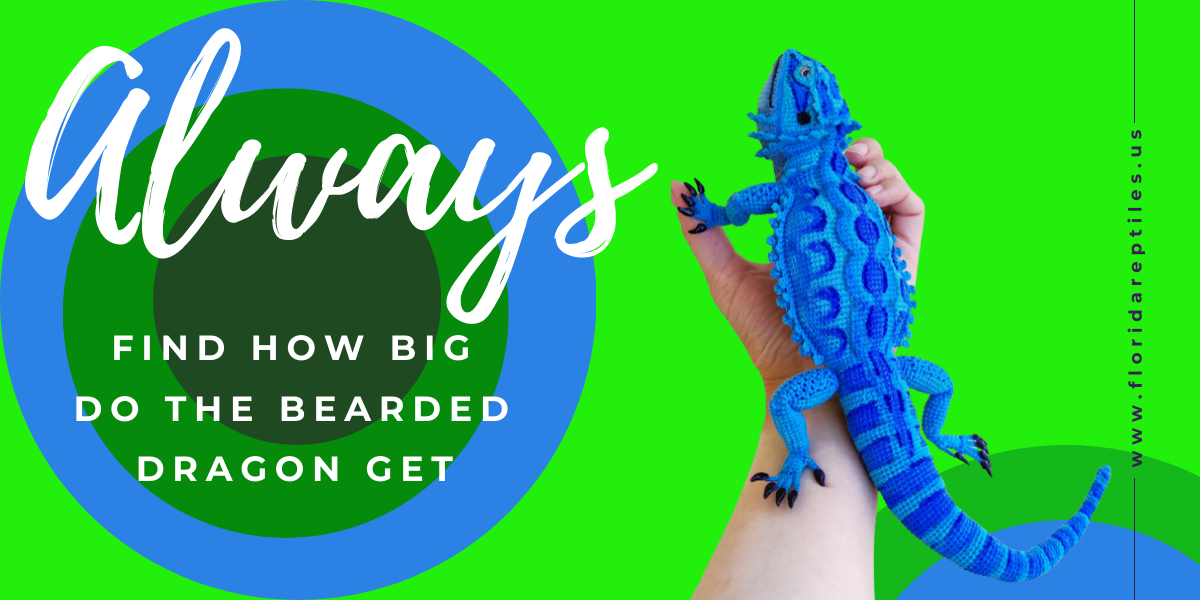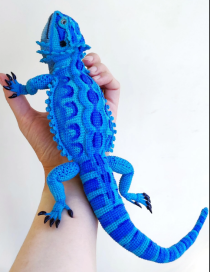- You have no items in your shopping cart
- Subtotal: $0.00
One of the most common questions among bearded dragon owners is How Big do a Bearded Dragon get? Bearded dragons are popular pets for reptile enthusiasts due to their unique appearance, easy care, and friendly demeanor. In this article, we’ll explore the size of bearded dragons, what factors influence their growth, and how to ensure that your pet is healthy and happy.
How Big Do a Bearded Dragon Get: Understanding the Basics
Bearded dragons, also known as Pogona Vitticeps, are native to the deserts of Australia. You might wonder How Big do a Bearded Dragon get? They are a type of lizard that can grow up to 24 inches in length from head to tail. These creatures are known for their spiky appearance and the “beard” of spikes around their necks.
How Big Do a Bearded Dragon Get: Hatchling Size
When bearded dragons hatch from their eggs, they are usually around 3-4 inches long from nose to tail. At this stage, they are fragile and require special care to ensure their survival.
How Big Do a Bearded Dragon Get: Juvenile Size
How Big do a Bearded Dragon get as juveniles, they can reach up to 12 inches in length within the first few months of life. At this stage, they are more active and curious, and they require a larger enclosure to accommodate their growth.
How Big Do a Bearded Dragon Get: Adult Size
Adult bearded dragons can reach up to 24 inches in length from head to tail. However, the size of these creatures can vary depending on several factors, including genetics, diet, and environment.
Factors that Affect Bearded Dragon Size
Several factors can affect How Big do a Bearded Dragon get, including genetics, diet, and environment.
a) Genetics
Genetics plays a significant role in determining the How Big do a Bearded Dragon get. Some bearded dragons are naturally larger than others, and their size can be influenced by the size of their parents.
b) Diet
Diet is another critical factor that can affect the size of bearded dragons. A healthy diet rich in protein and calcium can help these creatures grow and develop properly.
c) Environment
The environment in which bearded dragons are kept can also affect How Big do a Bearded Dragon get. An enclosure that is too small or lacks proper lighting and temperature can stunt their growth and development.
How Big do a Bearded Dragon get? Measuring Bearded Dragon Size
There are two primary ways to measure the size of a bearded dragon: body length and weight.
1) Body Length
To measure the body length of a bearded dragon, start at the tip of its nose and measure to the end of its tail. It’s essential to measure the length of the body and not include the tail in the measurement.
2) Weight
To weigh a bearded dragon, use a kitchen scale or a reptile scale. Place the lizard on the scale and wait for the weight to register. It’s crucial to monitor the weight of your bearded dragon regularly to ensure that it’s healthy and not losing or gaining too much weight.
Tips for Ensuring Your Bearded Dragon Grows Healthy and Happy
Here are some tips to help ensure that your bearded dragon grows healthy and happy:
a) Diet and Nutrition
Provide a healthy diet that includes live insects, vegetables, and fruits to keep them healthy.
b) Lighting and Temperature
Bearded dragons require specific lighting and temperature to thrive. They need access to both UVA and UVB lighting to help with calcium absorption and to prevent metabolic bone disease. The basking temperature should be around 95-110°F, while the cooler side of the enclosure should be around 75-85°F.
c) Habitat and Enclosure
The enclosure for your bearded dragon should be large enough to accommodate its growth. A minimum size of a 40-gallon tank is recommended for adult bearded dragons. Provide a basking spot, hiding spots, and climbing areas to create a comfortable and stimulating environment.
d) Exercise and Handling
Bearded dragons are active creatures and require exercise and handling to stay healthy and happy. Allow your pet to roam around and explore, but supervise them to prevent any accidents. Regular handling can also help socialize your pet and build a bond with them.
Does Bearded Dragons Bite?
Bearded dragons are generally friendly and docile pets, but they may bite on occasion. Here are two subtopics to explore in more detail:
Reasons for Biting:
Bearded dragons may bite for several reasons, including fear, aggression, territorial behavior, or mistaking a finger for food. If your pet is feeling threatened or stressed, it may bite as a means of self-defense.
https://youtube.com/shorts/MSMBUJVZfIE?feature=share
How to Prevent Biting:
Preventing biting in bearded dragons involves understanding their behavior and body language. Avoid sudden movements, loud noises, or touching them when they are asleep or not expecting it. Ensure your pet is well-fed and comfortable in their enclosure, and avoid handling them during shedding or illness. If your bearded dragon shows signs of aggression or biting, consult a veterinarian or reptile expert for advice on handling and training techniques.
By understanding the reasons for biting and how to prevent it, you can create a safe and comfortable environment for your bearded dragon, reducing the risk of biting and promoting a healthy and happy relationship between you and your pet.
Bearded Dragon for Sale
If you’re considering purchasing a bearded dragon, there are several important factors to keep in mind. Here are two subtopics to explore in more detail:
Where to Buy a Bearded Dragon
When looking to buy a bearded dragon, it’s important to find a reputable breeder or pet store like Florida Reptiles. Avoid purchasing from online classified ads or unlicensed breeders, as they may not provide the necessary care and attention to their animals. Research potential breeders or stores and ask for recommendations from experienced reptile owners or veterinarians. You can also research How Big do a Bearded Dragon get, so you can build proper encloser for them.
Cost of Owning a Bearded Dragon
While the initial cost of purchasing a bearded dragon may vary depending on the breeder or store, there are additional costs associated with owning and caring for your pet. These costs may include a suitable enclosure, heating and lighting equipment, food, and veterinary care. Be sure to consider these expenses before purchasing a bearded dragon and ensure that you can provide the necessary care and attention for the duration of your pet’s lifespan.
By understanding where to purchase a bearded dragon and the associated costs of ownership, you can make an informed decision about adding a new pet to your family. With proper care and attention, bearded dragons can make loving and rewarding pets.
Can Bearded Dragons Eat Grapes?
Bearded dragons are omnivores and require a balanced diet of both animal and plant-based foods. Here are two subtopics to explore in more detail:
Safe Foods for Bearded Dragons
Bearded dragons can eat a variety of foods, including crickets, mealworms, vegetables, and fruits. However, not all foods are safe for them to eat. Avoid feeding your pet foods high in oxalates, such as spinach and kale, as they can interfere with calcium absorption and cause health problems. Additionally, avoid feeding your pet foods high in phosphorus, such as grains and seeds, as they can cause kidney problems.
Feeding Schedule for Bearded Dragons
Feeding your bearded dragon on a regular schedule is important for its health and well-being. Younger dragons may require more frequent feedings, while adults may only need to be fed every other day. Ensure that their diet is balanced and includes a variety of foods, as a diet lacking in certain nutrients can lead to health problems. It’s also important to provide fresh water at all times, as dehydration can be a serious issue for bearded dragons.
By understanding what foods are safe for your bearded dragon to eat and establishing a feeding schedule, you can provide your pet with the necessary nutrition for a long and healthy life. Consulting a veterinarian or reptile expert for advice on diet and feeding techniques can also be beneficial.
Conclusion
We hope you get all the information on How Big do a Bearded Dragon get and how to keep them healthy. Bearded dragons are fascinating creatures that can grow up to 24 inches in length from head to tail. The size of these creatures can be influenced by genetics, diet, and environment. By providing a healthy diet, appropriate lighting and temperature, a suitable enclosure, and regular exercise and handling, you can ensure that your bearded dragon grows healthy and happy.
FAQs
What is the average lifespan of a bearded dragon?
Can bearded dragons live in groups?
How often should I feed my bearded dragon?
Can I take my bearded dragon outside?
How can I tell if my bearded dragon is healthy?



